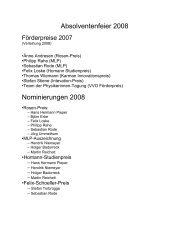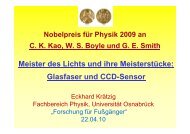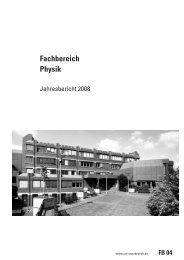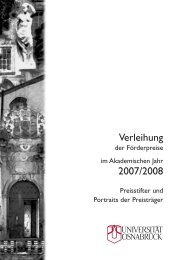Universität Osnabrück, Graduiertenkolleg Mikrostruktur oxidischer
Universität Osnabrück, Graduiertenkolleg Mikrostruktur oxidischer
Universität Osnabrück, Graduiertenkolleg Mikrostruktur oxidischer
Erfolgreiche ePaper selbst erstellen
Machen Sie aus Ihren PDF Publikationen ein blätterbares Flipbook mit unserer einzigartigen Google optimierten e-Paper Software.
GRADUIERTENKOLLEG MIKROSTRUKTUR OXIDISCHER KRISTALLE 25<br />
Computer simulations of defects in KNbO3 and KTaO3<br />
Beginn des Projekts: 01.02.1997<br />
Ende des Projekts: 31.03.1998<br />
Dr. Roberts Eglitis (Postdoktorand)<br />
Betreuer: Prof. Dr. G. Borstel<br />
Zusammenfassung<br />
Semi-empirical Hartree-Fock calculations using the intermediate neglect of differential overlapp<br />
(INDO) method, for self-ordered cubic symmetry clusters of seven Nb ions in KTaO3 are performed with the<br />
aim of verifying the cluster model [1] of second component-induced phase transitions in ferroelectric perovskite<br />
matrices. It is shown that such a seven-particle cluster in KTaO3:Nb has two types of quasidegenerate states of<br />
different nature. Namely, the state with the equilibrium full-symmetric dilatation and off-center displacements in<br />
[111]-directions of the central Nb-ion in the cluster, and the state with the equilibrium full-symmetric compression<br />
without any off-center effect. The consequencies of such cluster structures on the multi-well potential are<br />
discussed. In particular, an avalanche-like behaviour of the temperature dependence of the ferroelectric order<br />
parameter is obtained. The results of semi-empirical INDO calculations of a seven-impurities cluster of Nb-ions<br />
in KTaO3 confirm the key assumptions of the cluster model of induced phase transitions.<br />
The LMTO and INDO methods are used for a supercell study of F centers in cubic and orthorhombix<br />
ferroelectric KNbO3 crystals. Two electrons are found to be considerably delocalized even in the ground state<br />
of the defect. The absorption energies are calculated by means of the INDO method using the ∆SCF scheme<br />
after a relaxation of atoms surrounding the F center. As an example of another type of point defect in perovskite,<br />
an isolated Li impurity in KTaO3 as well as interacting Li pairs are considered in the supercell approach. The<br />
off-center Li displacement, reorientational energy barriers and the lattice relaxation around impurities are calculated.<br />
The results are compared with those obtained earlier within the shell model, revealing the relaxation pattern<br />
somehow different from the shell model estimations.<br />
We used INDO method for large unit cell calculations of hole polarons bound to a cation vacancy in<br />
partly covalent perovskite KNbO3. In KNbO3 we predict the existence of one-site and two site (molecular) polarons<br />
with close absorption energies ∼ 1 eV.<br />
Ergebnisse<br />
The exploration of the Nb-clusters in KTaO3 was performed using the periodic LUC method, as it is implemented<br />
in the updated CLUSTERD computer code [I,II,2,3]. In order to calculate the Nb clusters in KTaO3, we<br />
replaced in our 4×4×4 times extended unit cell, containing 320 atoms, seven Ta atoms by seven Nb atoms. After<br />
this, in order to find the energy minima of Nb clusters in KTaO3, we allowed to six Nb atoms to relax towards<br />
the central Nb atom. The results of our calculations show that for six Nb atoms shifted symmetrically towards<br />
the central Nb atom by 0.187 Å, the total energy per LUC is lowered by 0.088 eV. Moreover, the outward uniform<br />
displacement of six Nb atoms from the central Nb by 0.073 Å is also favorable and lowers the energy by<br />
approximately 0.03 eV. In the case, when 6 Nb atoms are shifted outwards from the central Nb atom, the central<br />
Nb-atom moves off-center from central position in the [111] direction by 0.27 Å, further lowering the total energy<br />
of system by 0.09 eV. These configurations correspond to a ground-state vibronic multiplet. The Nb atom<br />
reveals also an instability in the [100] direction. The shift of the central Nb ion along the [100] direction by<br />
0.192 Å lowers the cluster energy additionally by 0.056 eV in the same case when six Nb atoms are shifted<br />
outwards from the central Nb atom. The total cluster-structure induced energy lowering in the ground state,<br />
which corresponds to the situation when six Nb atoms are symmetrically shifted in the direction from the center<br />
of the Nb cluster, and the central Nb atom is off-center in the [111] direction is 0.12 eV [III]. According







